Rocks in my Pockets (Baumane, 2014)
Please permit me to say this right off the bat: Rocks in my Pockets deserves to be labelled a classic, for three supreme reasons. First, Signe Baumane’s debut contains engrossing storytelling. Second, its inventive and surprising animation offers up a 90 minute visual feast. Third, I can’t think of a better cinematic portrayal of mental illness, in this case crippling depression.
Allow me to expand on this third point. Beyond post-traumatic stress (Fearless and American Sniper immediately come to mind), filmmakers have a hell of a time getting mental illness right. Debilitating conditions like bipolar disorder or schizophrenia end up glamorized and sanitized. Meanwhile, the therapist-patient relationship almost inevitably traverses one of three paths: deranged control, inappropriate eroticism, or overidealization.
Remarkably, Rocks in my Pockets avoids these pitfalls. Just as incredibly, for a work of art about a family’s legacy of depression and suicide, Baumane’s film never becomes a lugubrious slog. A brisk tempo is maintained, thanks in part to a spry folksy score composed by Kristian Sensini and performed by a chamber ensemble. Baumane’s own narration, with varied voices for each character, also adds a light touch.
Clearly, this is a labor of love for the director. Besides doing all the voiceover work, Baumane also took on the roles of writer, animator, producer, and co-editor. She is also sharing her family’s own story. The first half of Rocks in my Pockets focuses upon Baumane’s grandmother Anna, and her life in Latvia across the first half of the 20th Century.
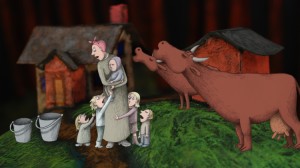
Anna, after becoming a secretary, marries her much older boss. During tumultuous times that include Communist revolutionary efforts, Soviet occupation, and Nazi invasion, Anna’s erratic husband relocates from urbane Riga to a rural locale.
There, educated Ana is forced into a peasant-like existence while churning out eight children. A genetic predisposition to severe depression no doubt mingled with desperation over unmet aspirations, leading to multiple suicide attempts and a mysteriously premature death.
From here, Rocks insightfully covers how Ana’s children sanctified their diligent mother in their family mythology, while multiple grandchildren wage their own wars against life-threatening depression. One of these troubled offspring is the director herself, who candidly portrays her own “therapy,” both during her youth in Soviet-era Latvia and after her emigration to New York City.
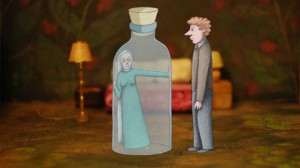
It would be hard to overstate the exponential impact of Baumane’s visuals upon a story that already had great potential. Living figures and invisible influences are illustrated using typical animation techniques, then superimposed upon papier-mâché objects, settings, and backgrounds. All of this is handled with a vividly metaphorical, fantastical style that is often surreal.
For instance, a cousin besieged by hallucinations commanding suicide is imagined as a woman progressively blockaded by wooden chess pieces. A closeup of another depressed cousin’s eyes reveals pupils replaced by slumped human figures facing inwards, away from everyone else’s view. Family elders unitedly voicing platitudes are shown as looming papier-mâché boulders.
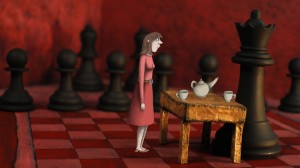
The lyrical expressiveness of the narration also elevates Baumane to the level of my two favorite literary chroniclers of mental illness, Andrew Solomon (The Noonday Demon) and Kay Redfield Jamison (An Unquiet Mind). Soviet-era pharmacology inflicted on a relative is likened to using “a hammer to cut fingernails…no one ever heard from her soul again.” Sharing her own fight against the Jupiter-strength gravity of depression, Baumane baldly states, “I move the muscles of my mask.”
Throughout Rocks in my Pockets, word and image communicate so many aspects of the experience of depression with deep authenticity. The shaming stigma of mental illness, falsely dismissed as character weakness or sin, comes through loud and clear. This is balanced by the honest conveyance of the sufferer’s temptation to use the sick role as justification to evade adult responsibility.
Perhaps most potently and disturbingly, we see and hear how alluring the siren song of suicide can be for the severely depressed. Personified as a perversely appealing, slithering figure, Suicide beckons from drowning waters or a strangling noose.
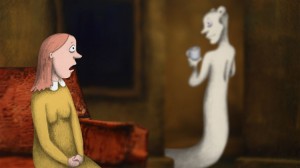
As a former customer and current giver of mental health services, I’m glad Rocks in my Pockets offers a hopeful alternative to a Young Werther-esque embrace of death. Beyond the hyperesthetic and numbing extremes of depression, hope most certainly exists. Happily, Baumane’s debut film, not to mention her life as a creator of exemplary art, demonstrates without a doubt that family history and faulty genes can be transcended.
5 out of 5 stars
(Parents’ guide: Rocks in my Pockets has not been rated, but given its subject matter and occasional earthiness, it probably would’ve earned an R rating. I would thus be selective in sharing this film with teens.)

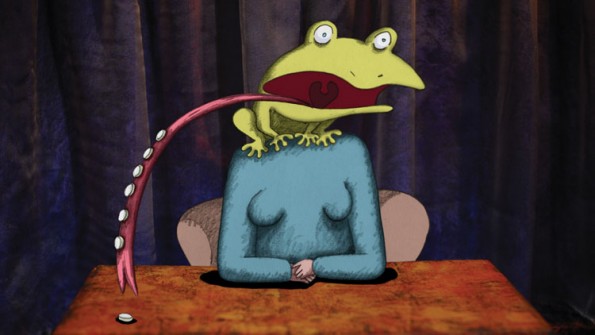
Intersting! What did you think about Silver Linings Playbook?
I thought it was a very charming story about a couple of people trying to put their lives back together. Mental health issues were handled decently, if not especially profoundly.